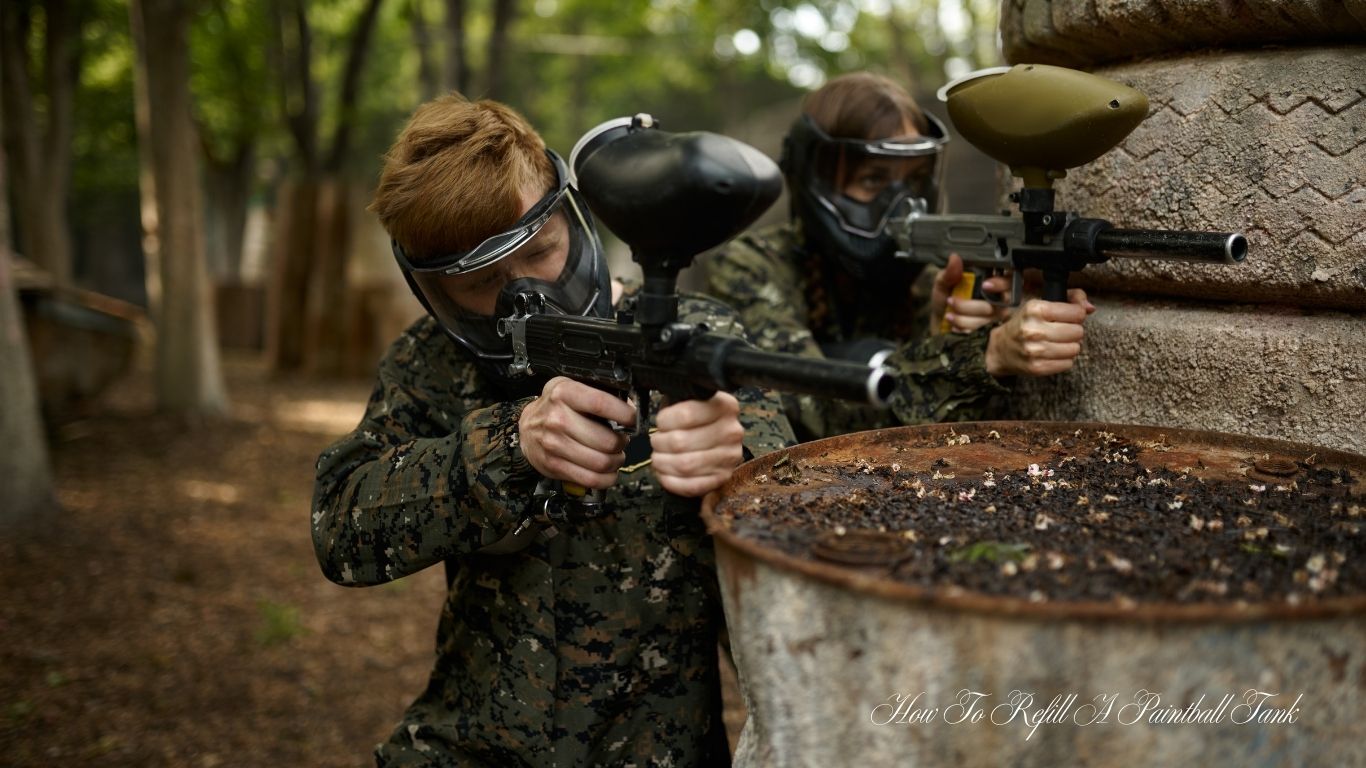Whether you’re gearing up for an intense match or just preparing for a casual game with friends, ensuring that your paintball tank is properly filled is essential for both safety and performance. For those new to the sport, this task might seem like a minor detail, but the reality is that knowing how to refill a paintball tank properly can have a major impact on your overall experience. A properly filled tank guarantees a smooth, uninterrupted game, while a poorly filled tank could cause your marker to malfunction or even risk safety. In this comprehensive guide, we’ll delve into the process of refilling both CO2 and HPA paintball tanks. We’ll explore the necessary steps, the right tools to use, the safety precautions you need to follow, and some common mistakes you should avoid. By the time you finish reading, you’ll be a paintball tank refilling expert, able to keep your gear in prime condition and avoid any mishaps during play.
Understanding the Two Main Types of Paintball Tanks
Before we dive into the nitty-gritty of refilling your paintball tank, it’s important to understand the differences between the two most common types of tanks used in paintball: CO2 tanks and HPA tanks.
CO2 Tanks
Carbon dioxide (CO2) tanks are the classic choice for many paintball players, especially beginners. These tanks are affordable and easy to use. When the CO2 is released from the tank, it expands from a liquid to a gas, providing the necessary pressure for your marker to shoot paintballs. However, one downside to CO2 tanks is that they are sensitive to temperature changes. In colder weather, the pressure in the tank can fluctuate, which can negatively affect your shooting accuracy and consistency.
HPA Tanks
High-pressure air (HPA) tanks are becoming increasingly popular, especially for more experienced players. Unlike CO2, HPA uses compressed air to power your marker, which offers more consistent pressure. The key advantage of HPA tanks is their performance in a wider range of temperatures, making them ideal for use in colder environments. While they tend to be more expensive than CO2 tanks, HPA tanks offer greater reliability, smoother shooting, and more consistent velocity. Understanding these two types of tanks will help you better prepare for the refilling process, as the steps for refilling a CO2 tank differ slightly from those for an HPA tank.
How to Refill a CO2 Paintball Tank: Step-by-Step Instructions
Refilling a CO2 tank is a straightforward process that, when done correctly, is safe and efficient. Here’s everything you need to know:
Gather the Necessary Equipment
To refill a CO2 tank, you’ll need the following:
- CO2 refill station or filling adapter
- A refillable CO2 cylinder (the source of your CO2)
- Your CO2 paintball tank
- Safety gloves and goggles (optional but recommended for safety)
Inspect the CO2 Tank
Before refilling, always check your CO2 tank for any visible signs of damage. Look for dents, rust, cracks, or leaks. A damaged tank is unsafe to refill and should be replaced immediately.
Attach the Refill Adapter
The refill adapter should be securely connected to the valve of your CO2 tank. Ensure it’s fastened tightly to avoid any leaks during the refilling process.
Refill the Tank
With the refill adapter in place, slowly open the valve of the CO2 refillable cylinder. The CO2 will begin transferring to your paintball tank. During the filling process, you’ll hear a hissing sound, which is a sign that the CO2 is entering the tank. Pay close attention to the tank while it’s being filled. You’ll want to stop the process when the hissing sound slows down or ceases. This indicates that the tank is full, and further filling could lead to over-pressurization.
Check the Pressure
Once the tank is filled, it’s essential to check the pressure. This can be done using a pressure gauge. Be sure that the pressure is within the safe range, as indicated by your tank’s specifications.
Disconnect the Tank
After confirming that the tank is full, disconnect it from the refill station and store it in a safe, cool, and dry place.
How to Refill an HPA Paintball Tank: A More Detailed Approach
Refilling an HPA tank is a more involved process compared to CO2, given the high pressures at play. Here’s how you can safely and effectively refill your HPA tank:
Confirm the Pressure Rating
HPA tanks typically come with pressure ratings of either 3000 psi or 4500 psi. Before you refill, verify that your filling station matches your tank’s pressure requirements to avoid over-pressurization.
Inspect the HPA Tank
HPA tanks are under far greater pressure than CO2 tanks, so inspecting the tank before refilling is critical. Look for any visible damage such as cracks, rust, or dents. If you find any, do not proceed with refilling.
Connect to the Filling Station
Securely attach the HPA tank to the high-pressure fill station. Ensure the connection is tight to prevent any air from leaking during the process. HPA tanks require special equipment due to the high pressure, so make sure you’re using the correct type of fill station.
Refill the Tank
Open the fill station valve gradually. You won’t hear the same hissing sound that you do with CO2 tanks. Instead, the air will gradually fill the tank at high pressure. Monitor the process closely to avoid overfilling.
Monitor the Pressure
Use a pressure gauge to ensure that your HPA tank reaches the appropriate pressure. Do not exceed the recommended pressure for your tank, as this can cause serious safety issues.
Disconnect and Store Safely
Once your HPA tank has reached its maximum pressure, carefully disconnect it from the refill station. Store the tank in a cool, dry place, and make sure it’s out of direct sunlight or heat sources.
Safety Tips for Refilling Your Paintball Tank
Handling pressurized gas tanks comes with inherent risks. To keep both you and your gear safe, follow these essential safety tips:
Wear Protective Gear: Even though the process is generally safe, wearing protective gloves and goggles is highly recommended when refilling your tank. Safety should always come first.
Refill in a Ventilated Area: Always refill your CO2 tank in a well-ventilated space, preferably outdoors. CO2 gas is heavier than air and can accumulate in poorly ventilated areas, creating dangerous conditions.
Check for Leaks: After refilling, always check for leaks using a soapy water solution. Apply the solution around the valve and connection areas; if bubbles form, there’s a leak, and you should replace the O-rings or the tank.
Do Not Overfill: Overfilling a paintball tank can lead to dangerous pressure buildup, and in extreme cases, a tank could rupture. Always stop filling once the tank is full, and monitor the pressure closely.
Store Tanks Properly: Never store a filled paintball tank in direct sunlight or extreme heat. High temperatures can cause the gas inside to expand, increasing the risk of tank rupture. Instead, keep your tank in a cool, dry area, and always store it upright.
FAQs
Q. Can I refill my CO2 tank at home?
A. Yes, as long as you have the proper equipment, such as a CO2 refill station, it’s safe to refill your CO2 tank at home.
Q. How long does a full paintball tank last?
A. This depends on the size of the tank and how frequently you shoot, but generally, a CO2 tank can last between 500-1000 shots, while an HPA tank can last longer.
Q. What should I do if I accidentally overfill my tank?
A. If you overfill your tank, stop immediately and release some pressure by slowly opening the valve. Never attempt to use an overfilled tank, as it can lead to damage or rupture.
Q. How often should I inspect my paintball tank?
A. You should inspect your tank before every use for any signs of damage. Regular inspection helps ensure that your equipment is in safe working condition.
Q. What happens if I use the wrong type of gas for my tank?
A. Using the wrong gas, such as filling an HPA tank with CO2 or vice versa, can lead to tank failure or damage to your paintball marker. Always use the correct gas for your specific tank.
Conclusion
Learning how to refill a paintball tank is an essential skill that all players should master. Whether you’re using CO2 or HPA tanks, understanding the steps involved in refilling and maintaining your gear can make a huge difference in the performance and longevity of your equipment. By following the proper procedures, checking for damage, and adhering to safety guidelines, you can ensure that your paintball gun are always ready for action, giving you a competitive edge on the field.


Leave a Reply